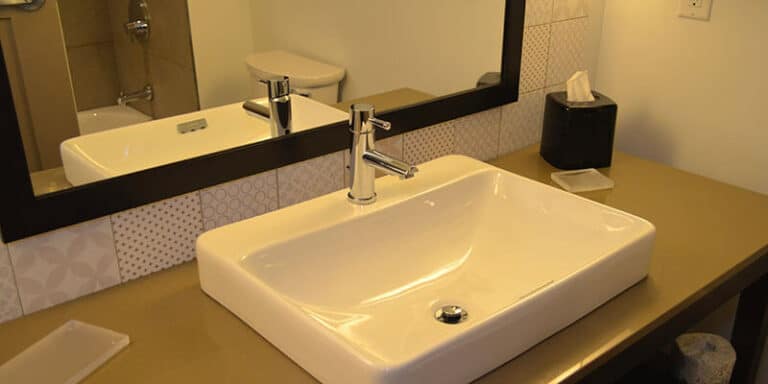When remodeling your bathroom, it’s important to consider the height of the bathroom vanity. A bathroom vanity, which combines a sink with storage, serves as a functional centerpiece.
The height of a bathroom vanity affects daily usage and comfort, making it important to select an option that suits the users of the space. For example, in household bathrooms, comfortable height vanities can prevent the need to stoop, offering ease of use for taller individuals. Considering the storage and plumbing hidden behind the vanity facade, the right selection not only is pleasing to the eye but also functional, streamlining your bathroom routine and maintaining a clutter-free environment.
Standard vanity heights range from 30 to 34 inches, while comfort height vanities are typically 34 to 36 inches, catering to the average adult standing posture.
Key Takeaways
- The height of the bathroom vanity has a significant impact on comfort and functionality.
- Standard vanity heights are typically between 30 to 34 inches, while comfort heights range from 34 to 36 inches.
Why Is Bathroom Vanity Height Important?
Selecting the right height for your bathroom vanity is crucial as it directly impacts ergonomics, which promotes comfort and helps in avoiding back pain due to bad posture.
if you’re considering selling your home in the future, the right vanity height can influence the resale value. A bathroom that accounts for both design and user-friendly features can be a compelling aspect for prospective buyers. It signals that the home is well-cared for and can adapt to diverse needs, heightening overall interest and potentially accelerating the sale process.
Standard Vanity Sizes
When selecting the ideal vanity for your bathroom, understanding the standard dimensions can guide your choices. Here’s what you need to know about the typical vanity sizes.
Bathroom Vanity Height: Most vanities come with a height ranging from 30 to 36 inches. The vanities at the lower end (30 to 34 inches) are standard heights, while those at the higher range (34 to 36 inches) provide comfort height, better suited for individuals who are taller.
Bathroom Vanity Width: The width of bathroom vanities is quite variable. For a single-sink vanity, expect widths between 24 and 48 inches. Double-sink vanities, providing ample space for two people, typically range from 60 to 72 inches wide.
Bathroom Vanity Depth: In contrast, vanity depth is less varied but still important for room layout and plumbing considerations. The standard depth falls between 17 to 24 inches.
Listed below are average bathroom vanity widths to consider for your storage needs:
- Single-Sink Vanity Widths:
- 24 inches
- 30 inches
- 36 inches
- 48 inches
- Double-Sink Vanity Widths:
- 60 inches
- 72 inches
Popular Bathroom Vanity Heights

understanding the popular options helps you make an informed choice that suits your needs.
Standard Vanity Height
In traditional bathroom setups, you’ll find vanities that stand 32 inches tall. This used to be the go-to height for many homes but is now often replaced by taller options to cater to modern preferences and comfort. This height may still be suitable for bathrooms that retain a vintage style or for family members of a certain height.
Comfort Vanity Height
To accommodate adults and enhance ergonomic usage, comfort height vanities range between 34 to 36 inches in height. These taller vanities reduce strain during use by limiting the need to bend over, making them more comfortable for most adults. If children are using the vanity, consider pairing it with a sturdy step stool for accessibility.
Other Heights (ADA)
For inclusive design that meets the Americans with Disabilities Act (ADA) standards, a bathroom vanity should ideally be 34 inches high. This ensures wheelchair access and caters to individuals with limited mobility, making the space usable and comfortable for everyone without the need for special accommodations.
Vanity Height Considerations
When choosing the ideal vanity height for your bathroom, it’s important to take into account the average user’s height, current vanity height, plumbing, sink style, available space, existing layout, and more.
Height of the Average User
The standard height for a bathroom vanity is typically between 30 and 34 inches. However, it’s important to consider the height of all household members. For families with taller members, you may want to add a few extra inches to accommodate their height, aiming for around 37-38 inches. Conversely, for families with shorter members, you may want to use a lower vanity height of 30-32 inches. If the vanity is for a public bathroom, it’s important to consider the average height of the users or guests.
Current Vanity Height
Any significant changes in height may require plumbing modifications, which can impact the cost. Additionally, adjustments to the height might require relocating electrical outlets, which is best handled by a licensed electrician. To avoid unnecessary costs, consider the current vanity height when choosing the bathroom vanity height.
Available Space and Existing Layout
In smaller bathrooms, space planning is critical. Ensure the new vanity allows enough clearance for bathroom doors and drawers to operate properly. Additionally, the height should not hinder traffic flow within the bathroom and must align with the size of the surrounding bathroom accessories.
Plumbing and Plugs
Your new vanity height should be compatible with existing water lines and drains to minimize costly plumbing alterations. Electrical outlets also need to be placed safely away from water sources, following local building codes to prevent hazards.
Sink Style
Different sink styles affect the overall vanity height:
- Vessel Sinks: Typically require a vanity height lower than standard to compensate for the basin’s additional height.
- Undermount Sinks: Generally compatible with standard vanity heights due to their recessed nature.
- Tabletop Sinks: The basin sits atop the vanity, so consider the added height when selecting the vanity itself.
Other Fixtures
The vanity should be in stylistic and functional harmony with other bathroom fixtures such as the shower, tub, or toilet. Cohesiveness in design and proportional height alignment with these elements is crucial for a unified appearance.


